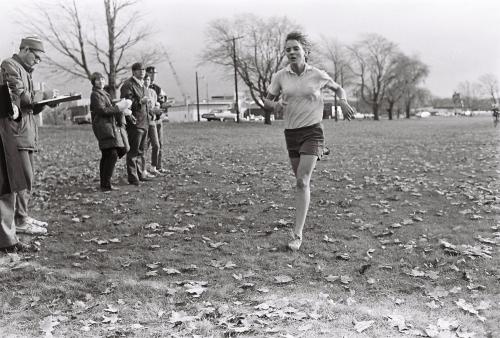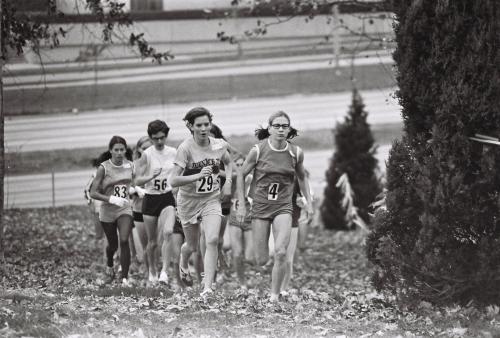Today (March 8, 2022) is International Women’s Day. The following piece came to #RunBlogRun from Rich Engleheart and Jeff Johnson four years ago. It is the story of Janet Bristol, an incredible distance runner, who, for many reasons, had a very short, but brilliant career. I always think about Janet Bristol when I consider how many women did not get the chance to experience our sport to its very fullest.
Please enjoy the story and wonderful pictures. Rich is a master storyteller and Jeff is one of the finest photographers in our sport. I was fortunate to work with them both.
Originally posted on July 29, 2018.
Larry Eder/RunBlogRun does introduction: At the end of the day, we are storytellers. Our sport is about stories. Stories about the great ones, stories about the ones who have overcome great challenges, stories about those who could have been. Before the written word, our ancestors sat around campfires, listening to stories of the great ones before us.
This is the story of Janet Bristol, one of the U.S.’s most talented and precocious runners. By fifteen, she was a global player in the sport, and by seventeen, she was out of the sport.
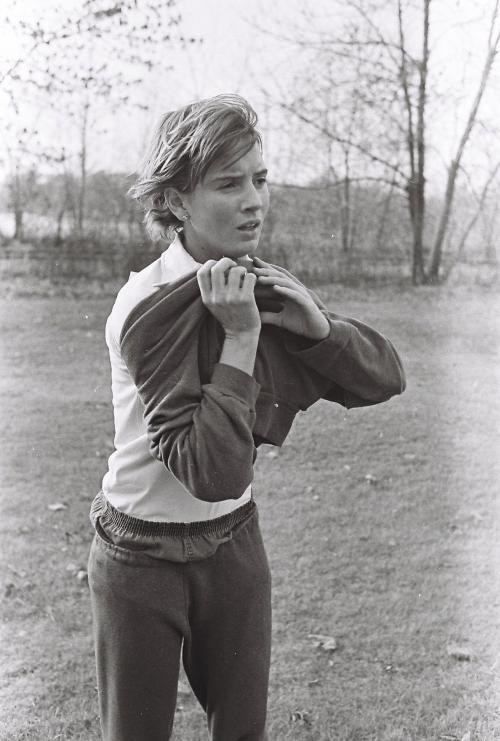 Janet Bristol, photo by Jeff Johnson (1970 New England AAU Cross Country)
Janet Bristol, photo by Jeff Johnson (1970 New England AAU Cross Country)
The fruition of this story is over three years. The story of Janet Bristol has been in the making for 47 years.
It started with a message from a friend in 2015. The friend wanted to tell me that Jeff Johnson, the man who, in a dream, came up with the name Nike for Phil Knight, wanted to speak to me. You see, Jeff Johnson, likes his privacy. One does not contact him directly, as he does not do answering machines.
After a career at Nike, where he helped build the brand with the great ones, Jeff went back to his first loves, photography and coaching. Much of the history of our sport in the 1960s and 1970s is due to the many photos taken by Jeff Johnson, who was everywhere. Jeff Johnson coached many, and his enthusiasm for the sport, is, well, infectious.
I met Jeff Johnson in the late 1970s, but I do not remember where. I knew of his photographs before I ever met Jeff. I heard stories about him. I learned about him through his pictures in Track & Field News. His affection for the focus of his photographs and his respect for the sport came through in all the work he did. I then saw Jeff Johnson again, on a plane in Manchester, New Hampshire in 1989, as I was working for a computer magazine publisher in Peterborough, New Hampshire. When I returned to California in the 1990s and began coaching some post collegiates while coaching at Foothill College with my mentor, Joe Mangan, I would see Jeff Johnson and Frank Gagliano on the Stanford golf course, and we would chat. Jeff and I would talk, as he finished his coaching sessions. Jeff wondered, out loud, how we made a living publishing American Track & Field (we barely did), and we spoke about training. I loved that time, speaking with Gags and Jeff, and tried to soak it all in. Many times, I wished I had a tape recorder.
I have saved a few holiday cards from Jeff. He sent me notes of encouragement around the holidays, and I have treasured them.
In the summer of 2015, Jeff and I spoke for about thirty minutes. He began to tell me the story about Janet Bristol, an athlete who he swore, could have medaled with Joan Benoit Samuelson in 1984. Jeff is not a man who used hyperbole, so I listened. The more I listened, the more I was intrigued.
Soon, a gentleman named Walt Chadwick sent me 20 glorious black and white pictures of Janet Bristol from 1970, photographed by Jeff Johnson. Walt also put me in touch with Jeff Englehart. It was like the time travel described in Kurt Vonnegut novels. I was seeing into a time and culture just before I began running, in Saint Louis, in 1972. Jeff Johnson had coached this very promising young woman, after he saw her crush the competition in the 1970 New England AAU cross country race. She then went to Saint Louis in the winter of 1971, after some coaching with Jeff Johnson, and finished fifth in the 1971 AAU cross countrytitle, going with Doris Brown Heritage, to the 1971 International, where she took fifth in the world! Fifth in the world at age of sixteen!
And then, it was over.
A year later, she ran her last race, a marathon, and she would not race again.
Walt Chadwick sent me pictures and introduced me to Rich Englehart, a fine writer. Rich produced the following story in spring of 2016. I put the story in my archive, as I was dealing with the illness of my mother, who passed away in the Fall of 2016. Over the next two years, with family tragedy and my health, my mind was not on much. I am just beginning to catch up on several things left undone. I had totally forgot about Janet Bristol.
Now, two heart surgeries later, both successful, my energy has returned.
And then, less that a week ago, I got a text from Tom Carleo, a VP at New Balance. I met Tom, a fine runner in his own rite, while he was at Nike. Tom has a wry sense of humor. He noted that he was having an adult beverage with a gentleman and that I had taken a story from him, and neither published it or paid him for the work. I found the story, read it, reached out to him and Walt Chadwick and, apologized to the writer, on this warm July day in 2018, you see the story of The Road Not Taken.
Janet Bristol, 1970 New England AAU champion, photo by Jeff Johnson
Do me a big favor. Please pass this one around. It is one of the most important stories ever to appear on our site or in our magazines. Thanks to Jeff Johnson, Walt Chadwick, Rich Englehart, Tom Carleo and, of course, Janet Bristol.
Janet, you are one of the great ones. Your story should be celebrated. Thanks for sharing your life with our readers.
THE ROADS NOT TAKEN, the untold story of Janet Bristol, by Rich Englehart
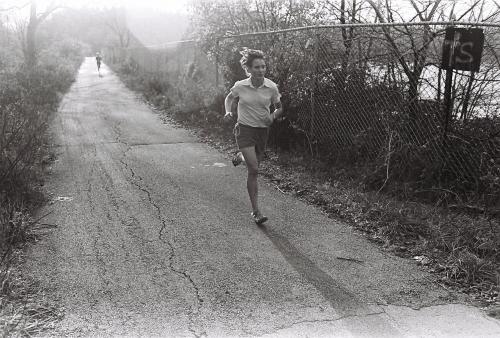 Janet Bristol, 1970 New England AAU, photo by Jeff Johnson
Janet Bristol, 1970 New England AAU, photo by Jeff Johnson
Girls, we are told, mature earlier in life than boys do. This should be a comforting thought to a fifth grade boy who has lost a one on one basketball game or a footrace to a fourth grade girl. It also may explain why the world of womenÃs sport consistently produces enormously successful athletes who have barely reached puberty and menÃs sports rarely do. There are few male counterparts to Chris Evert, Jennifer Capriotti, Olga Corbet, etc. In the distance running world, male prodigies emerge towards the ends of their high school careers. Jim Ryun’s and Gerry Lindgren’s international careers began as high school juniors. Subsequent high school runners to better the four minute mile have all done so as seniors.
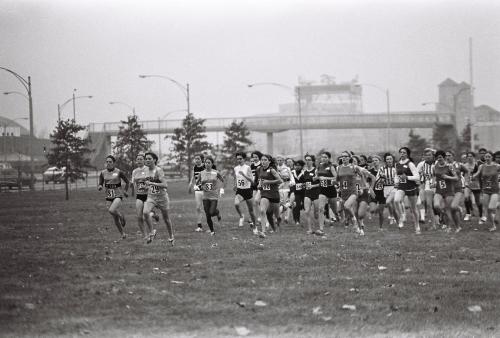 Start of 1971 AAU National Women’s Cross Country, Saint Louis, Missouri, photo by Jeff Johnson
Start of 1971 AAU National Women’s Cross Country, Saint Louis, Missouri, photo by Jeff Johnson
But there have been women distance runners, girls really, who were successful internationalists in the first half of their high school careers. Names like Mary Decker, Lynn Jennings, and Robin Campbell, all of whom will resonate with any long time fan of US track, were national or international caliber runners for most of their high school days.
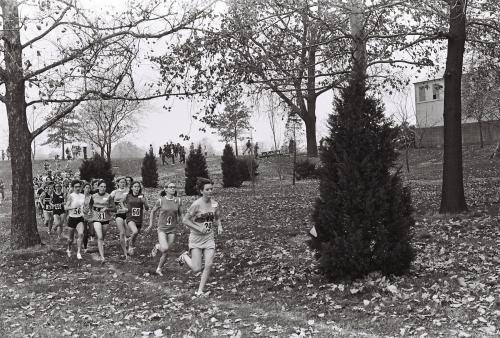 Janet Bristol leads, Dorish Brown-Heritage in second, 1971 AAU Women’s Cross Country, Saint Louis, Missouri, photo by Jeff Johnson
Janet Bristol leads, Dorish Brown-Heritage in second, 1971 AAU Women’s Cross Country, Saint Louis, Missouri, photo by Jeff Johnson
Janet Bristol and Doris Brown-Heritage, 1971, AAU Cross Country, photo by PhotoRun.net
And so it was that in the fall of 1970, fifteen year old Janet Bristol of Burlington, Vt. burst out of nowhere, well nowhere and Burlington, onto the nascent American and international womenÃs distance running scene with some amazing race performances, especially in cross country, and then vanished seemingly without a trace. Her story carries tragic elements and one cannot hear it without wondering what might have been.
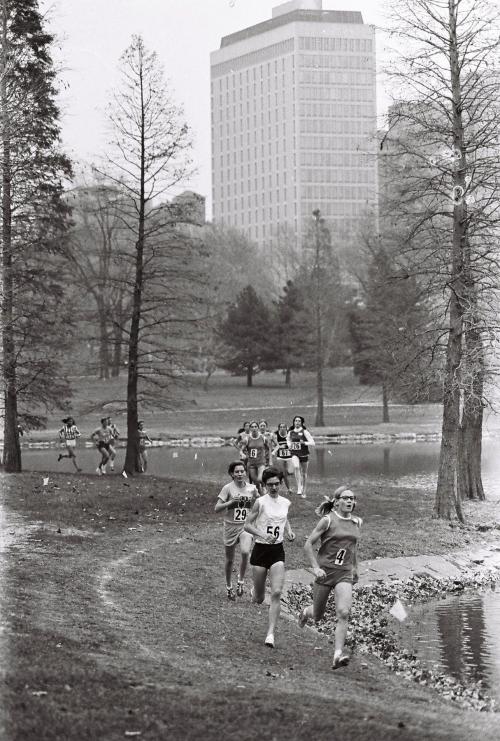 Doris Brown Heritage breaks open race, 1971 AAU Cross Country, photo by Jeff Johnson
Doris Brown Heritage breaks open race, 1971 AAU Cross Country, photo by Jeff Johnson
Janet was born in Burlington into what she describes as an ‘athletic’ family. She had three older brothers and an older sister.
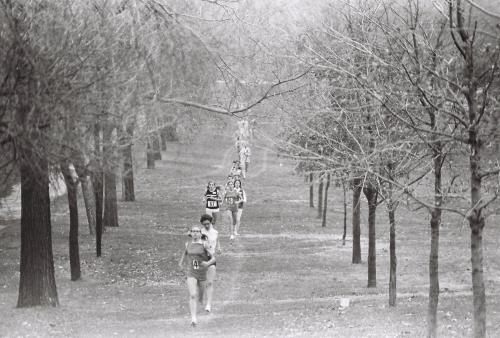 Doris Brown Heritage leads 1971 AAU Cross Country, Saint Louis, photo by Jeff Johnson
Doris Brown Heritage leads 1971 AAU Cross Country, Saint Louis, photo by Jeff Johnson
Both parents played tennis and golf. One of Her brothers played football, another played tennis and one was a body builder. Lynn (the sister) played basketball.
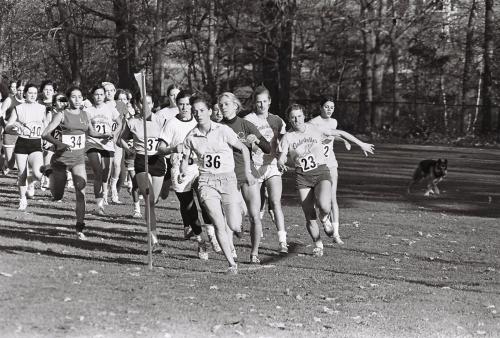 Janet Bristol leading, 1970, photo by Jeff Johnson
Janet Bristol leading, 1970, photo by Jeff Johnson
To get in shape for football, her brother ran. When Janet was eleven or so, she began tagging along on runs. She found that she really liked running and handled it well. She liked it better as the distances got longer. This preference would both create and limit her possibilities as she progressed through the sport. The longest sanctioned track race available to women in those days was a half mile. Women could compete nationally and internationally in cross country where the maximum allowable race distance was a bit beyond two miles, much longer than a half mile but still too short for the tastes and abilities of many women who were beginning to take up the sport then.
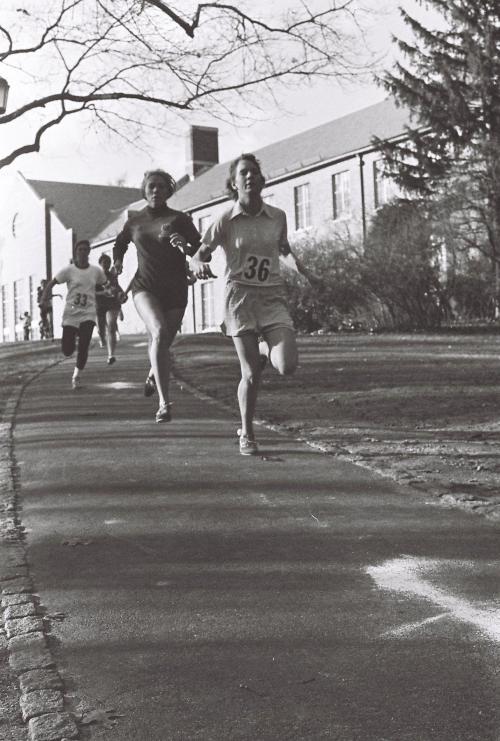 Janet Bristol, 1970, photo by Jeff Johnson
Janet Bristol, 1970, photo by Jeff Johnson
New England has always been a hotbed for distance running in the US. If you were a post collegiate runner looking to continue competing New England was one of the places to go. By 1970, the New England AAU, the AAU being a predecessor of USATF, was putting on cross country championship races for both men and women. The 1970 event was held at Fresh Pond in Cambridge, Ma. on a path that circles a reservoir.
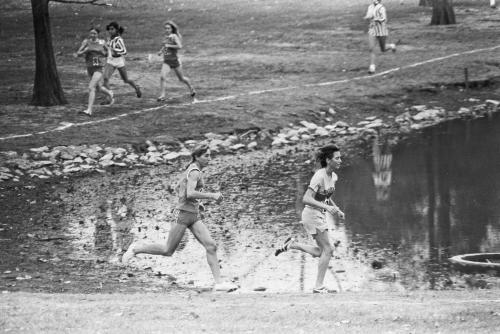 Janet Bristol, 1971 AAU Cross Country, photo by Jeff Johnson
Janet Bristol, 1971 AAU Cross Country, photo by Jeff Johnson
At the time, Jeff Johnson, future Nike Employee #1, was coaching the Liberty Athletic Club, a Boston based club for female runners. He was at the Fresh Pond race with the club runners and his wife at the time, Francie Kraker-Johnson, a 1968 and 1972 800 meter Olympian.
“Janet ran away and hid with that race,” Johnson recalls decades later.
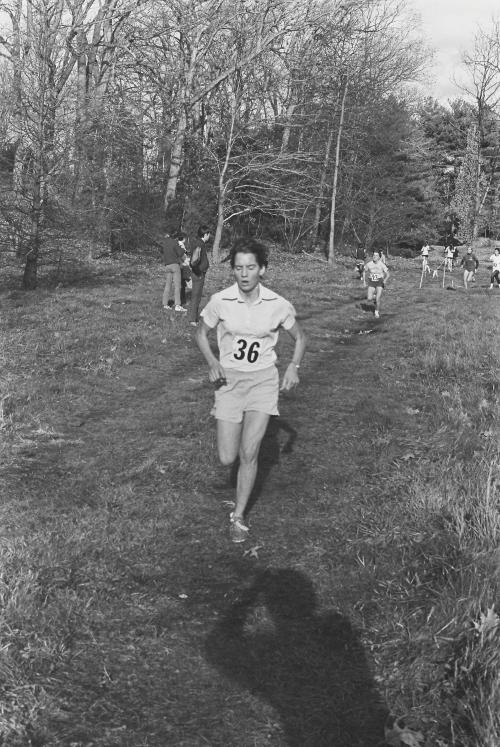 Janet Bristol, 1970 cross country, photo by Jeff Johnson
Janet Bristol, 1970 cross country, photo by Jeff Johnson
“Everything but Jan’s performance screamed ‘novice’. She raced in a polo shirt. She had no coach. Her dad had driven her to the event from Burlington. Neither he nor she had any idea about any other competitive opportunities that were available for her.”
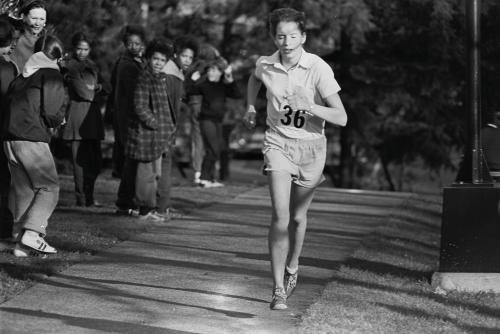 Janet Bristol, 1970, photo by Jeff Johnson
Janet Bristol, 1970, photo by Jeff Johnson
Johnson took the Bristols under his wing telling them, that as New England AAU champion, she had qualified for an expense paid trip to the National Championships in St. Louis early the next year. He offered coaching advice. And, he told them that there would be both a junior and senior championship race in St. Louis. At fifteen, Jan could choose to run in either race.
 Janet Bristol, 1970, photo by Jeff Johnson
Janet Bristol, 1970, photo by Jeff Johnson
“If she ran the junior race she’d probably win easily and they’d give her a real nice medal and send her home. But if she came in the top six in the senior race, which she was well capable of doing, she’d get to go to the International Cross Country Championship in San Sebastion, Spain.”
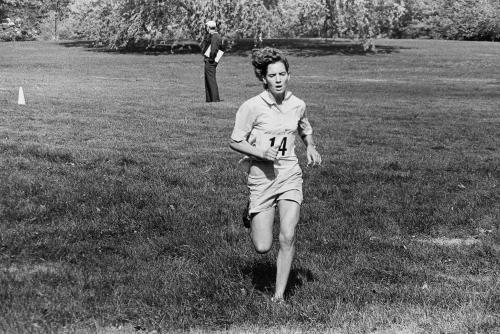 Janet Bristol, 1970, photo by Jeff Johnson
Janet Bristol, 1970, photo by Jeff Johnson
The International Cross Country Championship, forerunner to today’s World Cross Country Championship, was not sanctioned by the IAAF. It dated to 1903, originally held in the UK, and was originally a meet for Britain’s home countries, Wales, Scotland, and Ireland. Eventually France was invited and then other English speaking countries, Canada, Australia, New Zealand, the US, and other European countries were invited over time.
Janet ran the senior race and finished fifth qualifying for the International.
She matched that place in San Sebastian running 11:25 over a 2.8 mile course finishing seventeen seconds behind womenÃs winner and legend Doris Brown, four seconds out of second place. She recalls feeling terribly homesick for nearly the entire trip. But race day was rainy and muddy and Jan, who “loved glare ice, snow and rainstorms” (Johnson describes a 12 mile run Jan did in a blizzard in Boston’s Franklin Park before leaving for Spain running entirely on a 300 yard snow and ice free stretch of road.) because she thought training under adverse conditions made her tougher than everyone else, was in her element. The homesickness passed and she ran confidently.
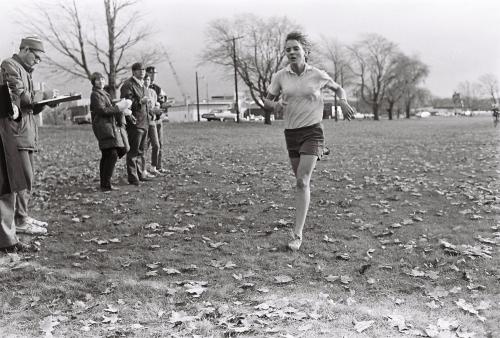 Janet Bristol, 1970 New England AAU, photo by Jeff Johnson
Janet Bristol, 1970 New England AAU, photo by Jeff Johnson
Jan was a pioneer in Burlington. Her Fresh Pond race wasn’t her first competition nor officially was the San Sebastian race her first international competition. At the time, there was an “International “track meet in Burlington, matching Burlington, Vt with a team from Burlington, On., offering a mile race for women. Jan won, as thirteen year old in 5:29. She was fourth that winter in an open mile, men and women, in an indoor meet at the University of Vermont in 5:28.
There were only boys’ teams in cross country and track at her high school but the coach, Duane Ranard, allowed her to run with them, at first unofficially and then finally as a full member, i.e., one who counted in the scoring, as a sophomore.
But not all was well. Lynn (Jan’s sister), had been diagnosed with schizophrenia. Before leaving for Spain, Lynn set fire to the family house. No human lives were lost but the family was traumatized and Jan lost some beloved pets.
And where do you go from up?
“I didn’t think there was anything I could do to beat Doris Brown when she was in her prime rather than when she was old,” (Jan was fifteen at the time and Johnson remembers Brown saying Jan was “loads of fun.”) And running didn’t seem to matter as much once I got back from Spain,” Jan recalls.
Her sister’s difficulties made her question whether it was selfish to invest the time and energy in herself and her running. Being unable to help Lynn broke her heart. There was no girl’s state championship to win. The 1972 Olympics had been a goal, but she thought the distances allowed for women were too short. And unlike today, there were few colleges offering scholarships to their women’s teams, because there were few women’s teams.
“I don’t think I’d have taken a college scholarship, even if I’d been offered one,” she confesses today. “When I was in sixth grade I figured out that I really didn’t like school. Twelve years of it was enough. I couldn’t imagine doing four more years.”
She ran her last race in the spring of 1972, but at the end of April 1972, ran a 26.2 mile Walkathon in 3 hours 20 minutes.
Always an animal lover, Jan got a job as a veterinarian technician, but soon switched to receptionist, and later, to administrative assistant because, “I couldnÃt deal with euthanasia.” She married, had a son and daughter, divorced after nine years, then remarried, adding two stepsons to the mix. Her daughter has four kids and her husband’s kids also have four, making Jan an eight-time grandmother. One grandson has been showing promise as a cross country runner. Working for a while at a ‘mom and pop, grocery store, stocking shelves, moving products, etc. wrecked her knees. Today she has two (knee) replacements.
She doesn’t dwell on what might have been. She currently does individual work in a residential facility for patients with dementia, which she finds rewarding. She loved her running and credits it for the inner strength and faith to have weathered life’s storms, but had no second thoughts about putting it aside when other things seemed to matter more.
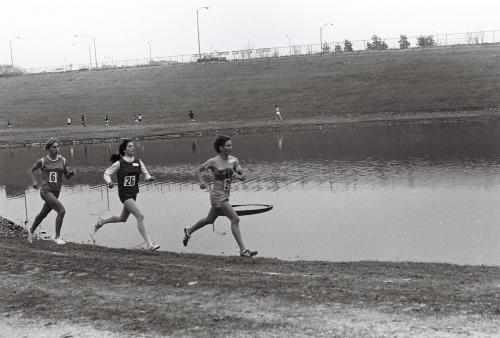 Janet Bristol, 1971 AAU Nationals, Saint Louis, Missouri, photo by Jeff Johnson
Janet Bristol, 1971 AAU Nationals, Saint Louis, Missouri, photo by Jeff Johnson
Jeff Johnson, who knows as much about women’s running as anyone, thinks she had the potential for a career that would have rivaled Mary Slaney’s or Joan Samuelson’s.
“Imagine,” he says, “the 1984 WomenÃs Olympic Marathon with Joannie and Jan in that race together. The US could have gone 1-2.”
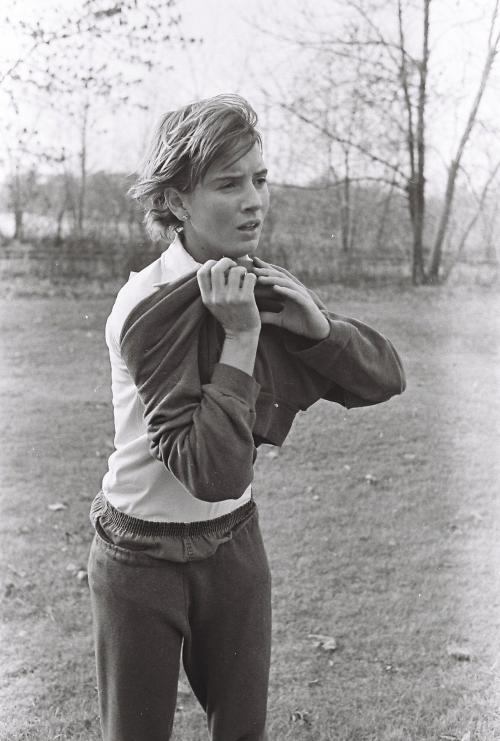 Janet Bristol, photo by Jeff Johnson
Janet Bristol, photo by Jeff Johnson
Author

Larry Eder has had a 52-year involvement in the sport of athletics. Larry has experienced the sport as an athlete, coach, magazine publisher, and now, journalist and blogger. His first article, on Don Bowden, America's first sub-4 minute miler, was published in RW in 1983. Larry has published several magazines on athletics, from American Athletics to the U.S. version of Spikes magazine. He currently manages the content and marketing development of the RunningNetwork, The Shoe Addicts, and RunBlogRun. Of RunBlogRun, his daily pilgrimage with the sport, Larry says: "I have to admit, I love traveling to far away meets, writing about the sport I love, and the athletes I respect, for my readers at runblogrun.com, the most of anything I have ever done, except, maybe running itself." Also does some updates for BBC Sports at key events, which he truly enjoys. Theme song: Greg Allman, " I'm no Angel."
View all posts

